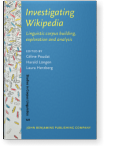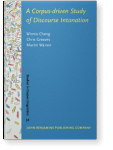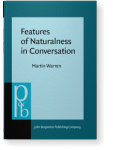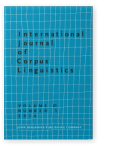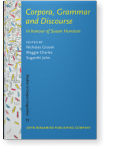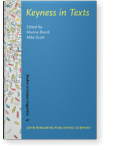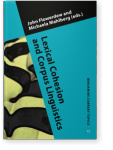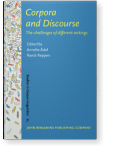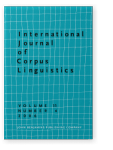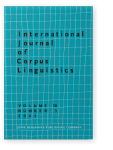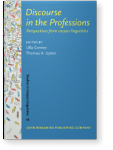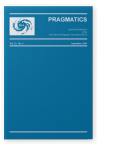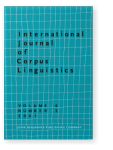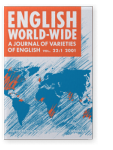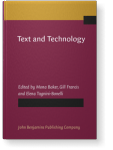Martin Warren
List of John Benjamins publications for which Martin Warren plays a role.
Book series
Titles
A Corpus-driven Study of Discourse Intonation: The Hong Kong Corpus of Spoken English (Prosodic)
Winnie Cheng, Chris Greaves and Martin Warren
[Studies in Corpus Linguistics, 32] 2008. xi, 325 pp. (incl. CD-Rom)
Subjects Corpus linguistics | Discourse studies | Electronic/Multimedia Products | English linguistics | Germanic linguistics | Pragmatics | Theoretical linguistics
Features of Naturalness in Conversation
Martin Warren
[Pragmatics & Beyond New Series, 152] 2006. x, 272 pp.
Subjects Discourse studies | Pragmatics
2016 Do collocational frameworks have local grammars? International Journal of Corpus Linguistics 21:1, pp. 1–27 | Article
This study extends the theory of local grammars by making the case that local grammars can also be employed to better and more fully describe the patterns of co-selection found in collocational frameworks (Renouf & Sinclair 1991). The term collocational framework was originally used to describe… read more
2015 Chapter 6. I mean I only really wanted to dry me towels because …: Organisational frameworks across modes, registers, and genres Corpora, Grammar and Discourse: In honour of Susan Hunston, Groom, Nicholas, Maggie Charles and Suganthi John (eds.), pp. 145–160 | Article
This study builds on the notion of ‘clause collocation’ (Hunston 2002: 75) and examines the use of this kind of co-selection across a variety of corpora. Hunston (2002: 75) notes that collocating clauses may begin with words and/or phrases which are co-selected. In this study, these co-selections… read more
2010 Identifying aboutgrams in engineering texts Keyness in Texts, Bondi, Marina and Mike Scott (eds.), pp. 113–126 | Article
This paper uses a new computer-mediated methodology, concgramming, to identify the aboutness of a text. Concgrams are the raw products of the concgramming process and consist of up to five co-occurring words irrespective of whether constituency variation (i.e. AB, A*B where * represents an… read more
2009 Cohesive chains and speakers’ choice of prominence Lexical Cohesion and Corpus Linguistics, Flowerdew, John and Michaela Mahlberg (eds.), pp. 45–63 | Article
This paper describes lexical cohesion across participants in a discourse, and across discourse events, and the additional contribution made by speakers’ choices of prominence in the cohesive chains. The choice of prominence is made to communicate what is perceived to be situationally informative in… read more
2008 7. // --> ONE country two SYStems //: The discourse intonation patterns of word associations Corpora and Discourse: The challenges of different settings, Ädel, Annelie and Randi Reppen (eds.), pp. 135–153 | Article
This study examines the relationship between the phraseological characteristics of language and the communicative role of discourse intonation (Brazil 1997). The findings are based on one of the four sub-corpora of the one-million-word Hong Kong Corpus of Spoken English (HKCSE), which has been… read more
2006 From n-gram to skipgram to concgram International Journal of Corpus Linguistics 11:4, pp. 411–433 | Article
Uncovering the extent of word associations and how they are manifested has been an important area of study in corpus linguistics since the 1960s (Sinclair et al. 1970). This paper defines and describes a new way of categorising word association, the concgram, which constitutes all of the… read more
2006 because of the role of er front office um in hotel: Lexical cohesion and discourse intonation Lexical Cohesion and Corpus Linguistics, Flowerdew, John and Michaela Mahlberg (eds.), pp. 305–323 | Article
This paper describes lexical cohesion across participants in a discourse, and across discourse events, and the additional contribution made by speakers’ choices of prominence in the cohesive chains. The choice of prominence is made to communicate what is perceived to be situationally informative in… read more
2005 //CAN i help you //: The use of rise and rise-fall tones in the Hong Kong Corpus of Spoken English International Journal of Corpus Linguistics 10:1, pp. 85–107 | Article
This paper examines the use of two tones by speakers across a variety of discourse types in the Hong Kong Corpus of Spoken English (HKCSE). Specifically, it focuses on the use of the rise and rise-fall tones by speakers to assert dominance and control in different discourse types. Brazil (1997)… read more
2004 // so what have YOU been WORking on REcently //: Compiling a specialized corpus of spoken business English Discourse in the Professions: Perspectives from corpus linguistics, Connor, Ulla and Thomas A. Upton (eds.), pp. 115–140 | Article
2003 Indirectness, inexplicitness and vagueness made clearer Pragmatics 13:3, pp. 381–400 | Article
The ability to do indirectness, inexplicitness and vagueness is a key component in the repertoire of all competent discoursers and these are commonplace phenomena in written and spoken discourses, particularly in conversations. The study reported in the paper seeks to delineate and exemplify these… read more
2001 The Functions of Actually in a Corpus of Intercultural Conversations International Journal of Corpus Linguistics 6:2, pp. 257–280 | Article
Using a corpus of naturally occurring conversations between native and non-native speakers of English in Hong Kong, we examine the use of actually in intercultural conversations. The frequencies with which the two groups of speakers use actually and the functions it performs are compared and… read more
2001 The use of vague language in intercultural conversations in Hong Kong English World-Wide 22:1, pp. 81–104 | Article
This paper presents the findings of a study of vague language use based on a corpus of naturally-occurring conversations between native and non-native speakers of English in Hong Kong. The specific concern of the paper is to describe the use of vague language by the two sets of speakers. The forms… read more
1993 Inexplicitness — A Feature of Naturalness in Conversation Text and Technology: In honour of John Sinclair, Baker, Mona, Gill Francis and Elena Tognini-Bonelli (eds.), pp. 37–54 | Article
